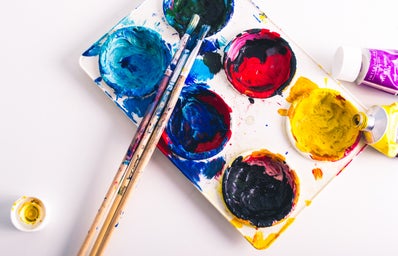Joan Miró i Ferrà (1893 – 1983) was a painter and sculptor born in Barcelona, Spain. Throughout his 90 years of life, he enchanted the world with his own artistic language, marked by the combination of a wild, deep and abstract work. His style involves mostly a fanciful and poetic vision of nature, and has been described as a “sandbox for his subconscious mind“. As he said himself, it was done in a very intuitive way:
“Never, never do I set to work on a canvas in the state it comes in from the shop. I provoke accidents – a form, a splotch of color. Any accident is good enough. I let the matiere decide. Then I prepare the ground by, for example, wiping my brushes on the canvas. Letting fall some drops of turpentine on it would do just as well. If I want to make a drawing I crumple the sheet of paper or I wet it; the flowing water traces a line and this line may suggest what is to come next.”
Joan Miró
PROFESSIONAL CAREER
According to Murilo José Dalla Costa, a brazilian journalist specialized in Joan Miró’s work by the Universitat Oberta de Catalunya (UOC), “in the trajectory of his life, Miró conceived an extensive and prolific work, marked, on one hand, by the constant dialogue with the avant-garde art movements of the 20th century; and on the other, by the search of an extremely personal interpretation of such influences”, he explains.
“In his oldest preserved documents, as the letters written to his hometown artist colleagues, it is already possible to identify the characteristics that would establish his artistic path, such as his deep connection with the Catalan landscape, his poetic sensibility and the frequent search for a unique and contemporary style”
Murilo José Dalla Costa
In his early life, Miró followed the artistic trade from his family, since his father was a watchmaker and a goldsmith. His passion towards drawing was remarkable since his childhood – he attended the School of Fine and Industrial Arts (the Llotja) in Barcelona at the age of 14, where he learned decorative and landscape art.
However, his parents wanted him to have a more practical career, and, following their wishes, Miró studied at a commercial college. Afterwards, he worked for two years as a clerk in an office until he had a mental and physical breakdown. Recovering in a farm outside Barcelona with his family, in Montroig, Joan Miró devoted himself to making art until he could finally attend an art school in his hometown, in 1912. His first solo exhibition, in 1918, was unsuccessful; his works were criticized and not a single canvas was sold. One year later, he was one of the many artists who made their way from abroad to Paris during the first two decades of the 20th century. Most of these foreign artists chose to become French citizens, but Miró remained attached to his Catalan roots.
As reported by Murilo José, Miró’s relation with his hometown was a bit contradictory – he was frequently complaining about the regional enviroment of Barcelona, but still had a feeling of affection and inspiration with the landscape, due to its rural and tradicional culture.
MAIN ARTWORKS
Joan Miró’s art was typified by different phases and styles: from the romanticism taught by his master, the painter Modest Urgell, to the avant-garde movements like Impressionism, Fauvism, Delaunay’s Orphism, Surrealism, and many others. He also worked with Primitive Catalan (Romanesque and Catalan Gothic), primitivism, detailing and childlike art. In the mature phase of his life, the graphism, abstract symbolism and the use of black and basic colors were remarkable, just as the experiment of other types of art, like ceramics, sculptures and gravures.
Here are some of the most important works from Miró:
- Enric Cristòfol Ricart’s portrait (1917)
Despite being made in the early years of Miró’s career, the portrait of Enric Cristòfol Ricart, a friend and partner of the artist, already defines characteristics that would mark Joan Miró’s future style. As Carolyn Lanchner, an art critic, observes, the artist plays with the avant-garde abstractionist geometrism of Neo-Plasticism in the composition of the painting, combining this influence with impressionist elements and the use of color in the Fauve style.
Indeed, another typical characteristic of Miró’s subsequent style is the combination of different compositional techniques, such as painting and collage. Finally, the portrait already shows the importance of color in Miró’s work, a characteristic that would become paradigmatic of the artist’s mature style.
- La Granja (1921-1922)
“La Granja” is an oil painting made between summer of 1921 and winter of 1922, while Miró was in Montroig; it’s a representantion of his family’s farm. He described this work as the key of his career: “it is the summary of a period of my work, but also the starting point for what would follow”. It’s the combination of a surrealist and art naïf – an instinctive work.
- Harlequin’s Carnival (1924 – 1925 )
“Harlequin’s Carnival” is one of the most remarkable surrealist paintings of the artist. It’s seen by many critics as the representation of dreams and the subconscious mind, and it is considered the highest point in Miro’s personal surrealist style. Along with “Persistence of Memory” by Salvador Dali, this artwork has become the most iconic image of the Surrealism Movement.
- Constellations (1940 – 1941)
As specified by the French historian and art critic Rémi Labrusse in his study “Miró, un feu dans les ruines“, published in 2004, the series of 23 paintings on paper gathered under the French name of “Constellations” would distinguish a moment of closure of Miró’s work. The paintings functioned as a cessation of the inner movement that would have, according to Labrusse, marked the artist’s previous work. They began in the summer of 1939, shortly before the invasion of France by Nazi troops in the seaside village of Varengeville-sur-Mer, located in the French region of Normandy.
The notebook of paintings accompanied Miró during his flight from France to his native Catalonia, along with his wife Pilar Juncosa and the couple’s daughter María Dolores. The artist and his family initially settled in Miró’s wife’s hometown of Palma de Mallorca, where the artist continued the series.
- Miss Chicago (1979)
This sculpture can be found at the Brunswick Plaza in Chicago, USA, and was initially titled as “The Sun, the Moon and One Star” as these are the fundamental component pieces of the sculpture. The piece is made of steel, wire mesh, concrete, bronze, and ceramic tile. Since this kind of piece is very expensive to make, Miró was only able to produce it once his career had taken off. It is classified as the greatest sculpture work of the artist.
In conclusion, throughout his 90 years of life, Miró was able to achieve a high and worthy spot in the artistic world, contributing with his unique interpretation of nature. Forty years after he passed away, the artist is still one of the most important names in the industry. Joan Miró’s work made him eternalized, and will be able to thrill and impress people decade after decade.
————————————————-
The article above was edited by Mariana do Patrocínio.
Liked this type of content? Check out Her Campus Cásper Líbero home page for more!


